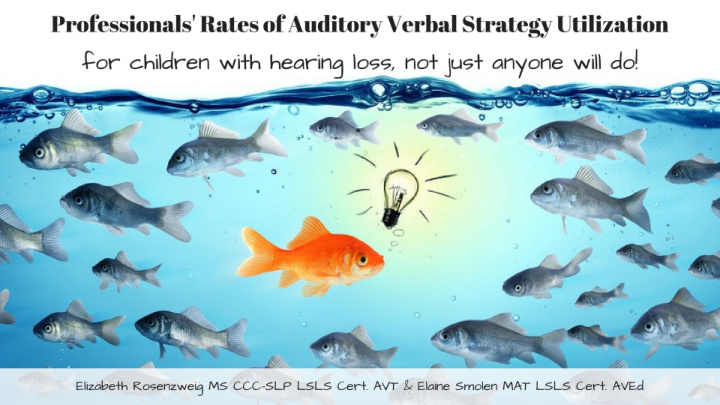



CASE STUDY #1 Mikayla was identified with profound bilateral SNHL at 3y0m and received bilateral CIs at 3y6m. Her local school district’s TOD has no prior CI experience, but the school district will not approve an out-of-district placement at an OPTION school one town over.
CASE STUDY #2 Addison’s family travels 3 hours one way to the CI center where he received his bilateral CIs at 12m. They cannot attend weekly for AV sessions. The local EI SLP has no prior experience, but the EI system argues that she is a highly qualified provider and will not approve AVT via teletherapy for the family.
THE PROBLEM Highly variable outcomes ● Highly variable personnel prep ● Lenihan, 2010; ASHA, 2016 ○ High demand for listening and spoken language (re)habilitation ● Alberg, Wilson, & Roush, 2006; Personal communication, D. Doak, ○ 2017 Limited access to HQPs ● AVI, 2002; AG Bell Academy for Listening and Spoken Language, ○ 2018 Lack of knowledge of evidence-informed strategies ● Fickenscher & Gaffney, 2016 ○
METHODS Electronic survey distributed via social media and ● professional network listservs from February - June 2017 n = 136 ○ Respondents were given a definition of each strategy and ● asked to report on their knowledge of/confidence with the strategy and how regularly they used the strategy Qualitative data collected as well ●
SURVEY DESIGN
RESULTS Most respondents reported using wait time, turn-taking, ● and expansion Usage of other strategies was more variable ● LSLS most likely to report using all strategies, followed ○ by those in certification process Non-LSLS least likely to report using all strategies ○ Logistic regression used to predict usage of each strategy ● by LSLS status, controlling for years of experience
WAIT TIME Wait time is the pause used between an adult’s interaction with a child and the child’s expected response that allows the child time to process the auditory information and formulate a response (Dickson, 2010). Video: wait time in action
Wait time - all respondents, regardless of LSLS designation, reported using
AUDITORY BOMBARDMENT Auditory bombardment provides numerous opportunities for a child to hear the target phoneme, sound or language (Dickson, 2010). Video: auditory bombardment in action
Auditory bombardment - no significant differences, but variation in what professionals called it: “input,” “bathing in sound,” “auditory soup,” “listening opportunities”
AUDITORY SANDWICH Through the use of the auditory sandwich, information is presented through listening before the introduction of visual or other support information is given to a child. When visual information is needed to assist in comprehension, the information is then put back into the auditory-only presentation. Video: auditory sandwich in action
Auditory sandwich - no significant differences, but variation in what professionals called it: “Circle of Listening,” “listen, listen, look, listen,” “listening first and last”
SELF-TALK/PARALLEL TALK Self-talk and parallel talk are indirect language stimulation techniques that do not require a response from the child. Self-talk: an adult talks to the child about what the adult sees, does, or hears at any particular moment in time. Parallel talk: an adult talks to the child about what the child does, hears or sees at any particular moment in time. Video: parallel talk in action
Self-talk/parallel talk - no significant differences, but variation in what professionals called it: “modeling,” “narration,” “thinking aloud,” “sportscasting”
“WHAT DID YOU HEAR?” When a child gives an incorrect or inappropriate response, no response, or experiences a communication breakdown, the adult can ask, “What did you hear?” to prompt the child to give back the part of the message that was heard and attempt to repair the breakdown.
“What did you hear?” - significant difference between LSLS and non-LSLS ( p = .0104)
AUDITORY FIRST Auditory first is an attitude as well as a set of conditions that will enable the child to have better access to speech and language. It includes ensuring the child has optimal, early access to audition through technology and providing opportunities to listen before looking or expecting a response.
Auditory first - significant difference between non-LSLS and those in the process ( p = .015)
WHISPERING A whisper is accomplished when the speaker turns off the voice and reduces the suprasegmental of intensity. Whispering is a form of acoustic highlighting.
Whispering - significant differences between LSLS and non-LSLS ( p = .00987), LSLS and in-process ( p = .01518)
MOTHERESE Motherese is the singsong voice that parents naturally use when speaking to very young babies. Motherese is also referred to as parentese, babytalk, or child-directed speech. Video: motherese in action
Motherese - significant difference between LSLS and non-LSLS ( p = .000847)
RESULTS Terminology confusion ● Particularly among non-US respondents ○ “Not effective” responses ● Patient/student age ○ Poor understanding of the scientific underpinnings ○ Children have poor auditory access ○
LIMITATIONS Sampling ● Exceptions ●
IMPLICATIONS Quantitative data to advocate for service provision by HQPs Though two providers may hold the same professional license, the services provided are not identical! Information to guide professional development What’s missing in our strategies instruction?
RESOURCES Fickenscher & Gaffney packet: http://bit.ly/FGpacket ● JTC Strategy Examples: bit.ly/JTCtips ● www.AuditoryVerbalTherapy.net
Recommend
More recommend